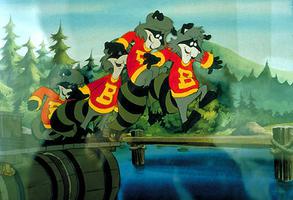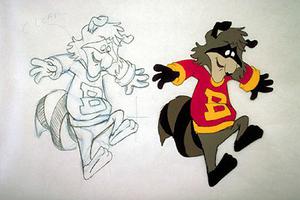Canadian Film Animation
Canada commands worldwide respect for its animators and work in film animation. This reputation has been built since 1942 and is largely, though not entirely, based on the legacy of Norman McLaren (1914-87) and the films produced by the National Film Board of Canada (NFB).
Animation Pioneers
The Quebec-born pioneering animator and director, Raoul Barré (1874-1932), created the first strip cartoon for Montréal's La Presse in 1902. He moved to New York where he founded one of the world's first animation studios in 1914. Barré wrote, directed and animated more than 30 shorts from 1914-19 and in the 1920s he worked on the early Felix the Cat cartoons. He is credited with several early innovations to the process of animation, some of which remain in use today. Victoria-born Stephen Bosustow (1911-81) began working professionally as a cartoonist in Hollywood in the early 1930s. He worked with Ub Iwerks and Walter Lantz, and joined the Walt Disney Studios as an animator/writer in 1934. In 1945, he and several other disenchanted Disney artists formed United Productions of America (UPA). UPA gave the world the near-blind Mr. Magoo and Bosustow won 2 Oscars for his cartoons.
Other Canadian pioneers in animation were Walter Swaffield, Harold Peberdy and Bert Cob; however, the first animated films, all predating 1920, have disappeared. In the 1920s a Toronto painter and illustrator, Bryant Fryer, began work on the first of a series of animated films called Shadow Laughs; only 2 films in the series of 12 were completed, both in 1927. Six years later he embarked on a new series, Shadowettes, producing 3 films using the silhouette technique made famous in Germany by Lotte Reiniger. Shortly afterwards, Fryer was forced to suspend his activities, and he moved into commercial production.
Norman McLaren and the National Film Board of Canada
These early attempts were all necessarily sporadic and unconnected. With the founding of the NFB in 1939, conditions were established that would guarantee continuity of production free from commercial pressures. Shortly after John Gierson was appointed to head the NFB, he asked his friend and former colleague, the gentle Scotsman Norman McLaren, to join him in Canada for "forty dollars a week and a chance to make films." In 1942, McLaren was put in charge of the fledgling animation department to produce short propaganda messages for the war effort. McLaren's effervescent imagination was applied to this task immediately. He also began to recruit young artists from across Canada to assist him, thereby laying the foundation for the future success of the NFB.With a minimum of means, animators such as George Dunning, Wolf Koenig, Colin Low, Jim McKay, Evelyn Lambart, Grant Munro and René Jodoin produced films of charm and vitality.
After the Second World War, McLaren turned his attention towards more personal projects, leaving a legacy that is legendary. Hen Hop (1942) and Begone Dull Care (1949; in collaboration with jazz great Oscar Peterson) are two good examples of his early work. His technical innovations, drawing directly on film and eliminating the need for a camera, were revolutionary. He widened the parameters of his art, employing unusual and diverse types of music and experimenting with abstract form. His "pixilation" (stop-motion) techniques of animating live actors were also extraordinarily imaginative. Both the Oscar-winning Neighbours (1952; made with Grant Munro), and the Oscar-nominated A Chairy Tale (1957; made with Evelyn Lambart) were made this way.
McLaren dazzled audiences around the world with his colourful, innovative films. In the 1960s he became fascinated with dance and broke new ground with another Oscar-nominated film, the beautiful Pas de deux (1967), a black-and-white visual poem that uses multiple exposures. He made his last film for the NFB, Narcissus, in 1983 and passed away in 1987. McLaren's films might be better classified as experimental rather than animation, and over the years he created a body of work that has no peer in all of cinema. He is Canada's most honoured filmmaker, perhaps a genius, who received literally hundreds of prizes and awards during his lifetime. His worldwide influence is indisputable.
A New Generation of Canadian Animators
While McLaren was quietly absorbed in his own work, a generation of animators began to develop their own techniques in the 1950s. With Colin Low's The Romance of Transportation in Canada (1953), a sense of character and incident entered animation at the NFB. As McLaren's successor as head of the animation department, Low helped foster the new generation of artists who entered the NFB in the late 1950s. Among them were Derek Lamb, Arthur Lipsett, Gerald Potterton, Robert Verrall and Sidney Goldsmith. McLaren gave informal classes to these youngsters, but the films they produced were quite different from his stylized works. Humorous shorts such as Les Drew and Kaj Pindal's What on Earth! (1966) and Potterton's My Financial Career (1963), both Oscar nominees, told tales in a manner that communicated directly to Canadian and international audiences.
The move of the NFB to Montréal in 1956 stimulated French animators Bernard Longpré, Yvon Mallette, Pierre Moretti and Pierre Hébert. By the late 1960s animation production had split along linguistic lines, and René Jodoin was made executive producer of a new French department of animation. Foreign talent such as Kaj Pindal from Denmark, Ishu Patel from India, Co Hoedeman from Holland and Bretislav Pojar from Czechoslovakia were brought in to augment a talented crew that included Québécois pin-screen wizard Jacques Drouin and the experimentalist Hébert.
In the 1970s, Peter Foldès used computer animation to criticize the consumer society in La Faim (1973; the first computer-animated short); Co Hoedeman created fantastic creatures out of sand in the Oscar-winning The Sand Castle (1977); Caroline Leaf used watercolour and ink on glass in The Street (1976); Ishu Patel used thousands of beads in the Oscar-nominated Bead Game (1977); Laurent Coderre used painstaking cutout animation in Zikkaron (1971); Bernard Longpré and André Leduc returned to pixilation with Monsieur Pointu (1975), and there was John Weldon and Eunice Macauley's Special Delivery (1978; Oscar for animated short), Eugene Fedorenko's Every Child (1979; another Oscar winner); and Janet Perlman's The Tender Tale of Cinderella Penguin (1981; an Oscar nominee).
From 1975-82, Derek Lamb oversaw the English side of animation at the NFB. The years following Lamb saw the continuation of excellence with Ishu Patel and George Ungar's Paradise (1985), Alison Snowden and David Fine's George and Rosemary (1987), Christopher Hinton's Blackfly (1991), Wendy Tilby and Amanda Forbis's When the Day Breaks (1999) and Torill Kove's My Grandmother Ironed the King's Shirts (1999), Oscar nominees all.
The NFB's stress on regional production in the 1970s resulted in many entertaining efforts from Vancouver, Winnipeg and Halifax. Winnipeg's production is especially distinguished with humorous films by Richard Condie - The Big Snit (1987) and La Salla (1997; an Oscar nominee) Ñ and Cordell Barker's hilarious The Cat Came Back (1989) and Strange Invaders (2001; another Oscar nominee), which have been widely seen by the public.
Due to government-imposed cuts to its operating budget, the NFB has cut back in other areas of production - mostly notably short dramas and features - but animation remains its crown jewel. The NFB continues to innovate and create some of the best animated films in the world, including co-productions with the private sector such as Sylvain Chomet's Les Triplettes de Belleville (2003), an Oscar-nominated feature produced with the UK, Belgium and France, Chris Landreth's Ryan (2005), and the Norwegian co-production The Danish Poet (2007), both Oscar winners. The NFB has won thousands of prizes at festivals worldwide for its animated films.
CBC Animation
In 1968, the CBC/SRC founded an animation studio. Directed by Hubert Tison, this studio, which first specialized in titles, credits and signature tunes, rapidly carved out for itself a fine reputation in the realm of scripted films. In effect, thanks to the remarkable talent of Frédéric BACK, Radio-Canada productions carried off a number of prizes at various festivals, including 2 Oscars for Crac! (1981) and L'Homme qui plantait des arbres (1987). In addition to Back's films, the studio went on to produce works by Graeme Ross (The Hare and the Tortoise/La Lièvre et la tortue, 1978) and by Paul Driessen (Jeu de coudes, 1979). Following severe budget cutbacks, CBC/SRC abandoned the production of animated films at the start of the 1990s.
Private Sector Animation Studios
Le village enchanté (1956), directed and animated by Marcel and Réal Racicot, was the first Canadian animated feature. CRAWLEY Films of Ottawa established an animation studio very early in its history and the CANADIAN FILM AWARD-winning The Loon's Necklace (1948), which recounts an old Indian legend, is still in active distribution. In the 1960s Crawley Films began to produce animation for the American networks, notably the first animated television series The Tales of the Wizard of Oz (1962) and Return to Oz (1963).
In the 1950s, Jim McKay and George Dunning left the NFB to found Canada's first private animation studio, Graphic Associates, in Toronto. After Dunning's departure for England in 1955, McKay changed the company name to Film Design Ltd, which continued production until his death in 2002. Winnipeg-born Al Guest formed his own company in Toronto in the early 1960s, and on the West Coast, the self-educated Al Sens opened his own studio in the 1980s. Gerald Potterton, another ex-NFB animator, formed his own company in Montréal in 1968; Potterton Productions produced many films of note, among them the feature-length Tiki Tiki (1971), before its demise in 1974. In 1975, Marv Newland founded International Rocketship, a very dynamic company in Vancouver that produced both commissioned and independent films. In 1969, Newland directed the cult short, Bambi meets Godzilla, in Los Angeles.
Potterton returned to the spotlight by directing Canada's most expensive animated feature film, Heavy Metal (1981), which became a box-office success. Hundreds of animators and production companies shared in this effort. Another independent animator is John Straiton, an advertising executive who worked in animation in his spare time. His Portrait of Lydia (1964) uses a succession of sexual images and symbols, and Eurynome (1970) is a technical wonder of plasticine.
Television Animation
One should note the prolific and high-quality Canadian contributions to animation in the medium of television, especially children's television. Several studios, such as Cinar and Ciné-groupe in Montréal, Mainframe Entertainment in Vancouver, and Nelvana Studio in Toronto concentrated on this genre. Perhaps the most successful example is Nelvana. Formed by three friends (producer Michael Hirsh, director Patrick Loubert and British-born animator Clive Smith) in Toronto in 1971, the company evolved - from a live-action and animation house that made local educational and broadcast fare, into one of the most important producers of children's television programs in the world. After the box office failure of its ambitious 1983 feature Rock and Rule nearly ruined the company, Nelvana recovered its equilibrium with the much safer The Care Bears Movie, which was a GOLDEN REEL AWARD winner in 1985 and a huge hit in the US. Following a decision to concentrate on the half-hour children's broadcast market, Nelvana went on to create such popular, high-quality series as Babar, Tintin and Little Bear. In 2000 Nelvana was bought by Corus Entertainment, and at first Smith then Loubert and finally Hirsh left the company they created. Hirsh went on to purchase Cinar, now known as Cookie Jar, responsible for the popular Caillou and Arthur children's series, among others.
Canadian Animators Abroad
Canadians have risen to the top of their profession abroad. Toronto-born, UK-based Richard Williams won an Oscar for his version of A Christmas Carol (1973) and was responsible for seamlessly combining animated characters with live-action in the blockbuster Who Framed Roger Rabbit (1988), winning another two Oscars for his groundbreaking work. Leaving Graphic Design, George Dunning (1920-79) set up shop in England and went on to direct one of the most famous animated films of all time, The Beatles' Yellow Submarine (1968). Steve "Spaz" Williams, a graduate from Sheridan College's world-famous animation program, made significant contributions to the creation of the digital dinosaurs in Jurassic Park (1993), turned Jim Carrey into a cartoon character in The Mask (1994; nominated for an Oscar for special effects) and designed the shape-shifting villain in James Cameron's Terminator 2: Judgment Day (1991).
Due to the outstanding legacy left behind by Norman McLaren and the NFB, Canadians dominate the world of animated features and shorts. It is not uncommon to find hundreds of unknown young Canadian animators contributing to the marvels from Disney, Pixar and Dreamworks such as Little Mermaid, Beauty and the Beast, Aladdin, Toy Story, Ice Age, Shrek, Wall-E and Up. As computer-animated films have come to dominate the theatrical market, Canadian-developed software such as Maya (the revolutionary software from Alias/Wavefront that allows animators to quickly and intuitively interact with the characters as digital puppets) is now the most widely used animation software in the world. NFB veteran Roman Kroitor is responsible for inventing the SANDDE hand-drawn stereoscopic animation system, which allows animators to directly draw in full stereoscopic 3D. Today, many of the major artists have their own sites for direct sales, as the World Wide Web is ideally suited to the art of animation.

 Share on Facebook
Share on Facebook Share on X
Share on X Share by Email
Share by Email Share on Google Classroom
Share on Google Classroom









